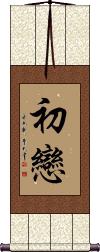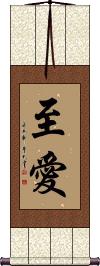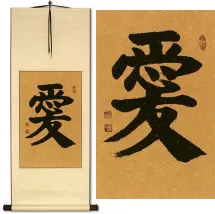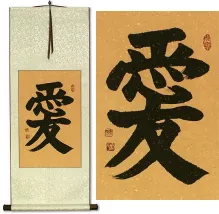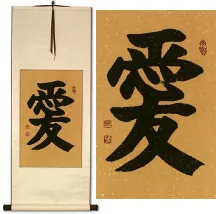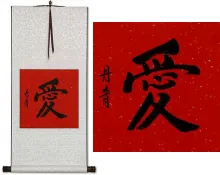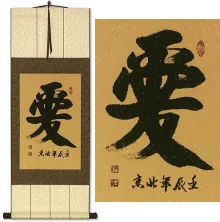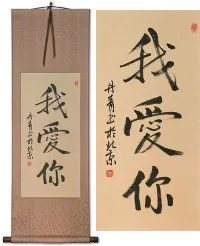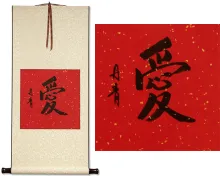Many custom options...
And formats...

First Love in Chinese / Japanese...
Buy a First Love calligraphy wall scroll here!
Personalize your custom “First Love” project by clicking the button next to your favorite “First Love” title below...
First Love
初戀 means “first love” in Chinese and Japanese.
You could also say that it means “first crush,” “first affection,” or “puppy love.”
![]() In Japanese and Simplified Chinese, they write the second character as shown to the right. If you want this version, click on the characters to the right instead of the Select and Customize button above.
In Japanese and Simplified Chinese, they write the second character as shown to the right. If you want this version, click on the characters to the right instead of the Select and Customize button above.
Best Love / Most Sincere Love
至愛 can mean the best love or most sincere love of your life.
This could be a romantic love such as your love for your spouse or a boyfriend/girlfriend.
It can also apply to the extreme love you have for your children or a parent and maybe a really good friend.
See Also: I Love You
Best Love / Most Sincere Love
Love Myself First
This directly translates as, “First, love myself.”
While you might be looking for “Love yourself first,” there's the problem with yourself versus myself. If this is on your wall or tattooed on your arm, should it not say “myself” since it's directed at you, and not others?
See Also: Love Yourself First
Love Yourself First
This directly translates as, “First, love yourself.”
Because this uses “yourself” instead of “myself,” this is a direction for those reading it. It could be the owner of the art or those who view it.
This would be weird as a tattoo, so please avoid it since for whom the tattoo is directed would be confusing.
See Also: Love Myself First
This in-stock artwork might be what you are looking for, and ships right away...
Gallery Price: $200.00
Your Price: $79.88
Gallery Price: $87.50
Your Price: $39.00
Gallery Price: $200.00
Your Price: $122.88
Gallery Price: $265.00
Your Price: $99.88
Gallery Price: $65.00
Your Price: $39.88
Gallery Price: $65.00
Your Price: $39.88
Not the results for First Love that you were looking for?
Below are some entries from our dictionary that may match your First Love search...
| Characters If shown, 2nd row is Simp. Chinese |
Pronunciation Romanization |
Simple Dictionary Definition |
初恋 see styles |
uren うれん |
More info & calligraphy: First Love |
初戀 初恋 see styles |
chū liàn chu1 lian4 ch`u lien chu lien hatsukohi はつこひ |
More info & calligraphy: First Love(surname) Hatsukohi |
三惑 see styles |
sān huò san1 huo4 san huo sanwaku; sannaku さんわく; さんなく |
{Buddh} three mental disturbances A Tiantai classification of the three delusions, also styled 三煩惱; 三漏; 三垢; 三結; trials or temptations, leakages, uncleannesses, and bonds. The first of the following three is common to all disciples, the two last to bodhisattvas. They arise from (a) 見, 思, 惑 things seen and thought, i.e. illusions from imperfect perception, with temptation to love, hate, etc.; to be rid of these false views and temptations is the discipline and nirvāṇa of ascetic or Hīnayāna Buddhists. Mahāyāna proceeds further in and by its bodhisattva aims, which produce their own difficulties, i.e. (b) 塵沙惑 illusion and temptation through the immense variety of duties in saving men; and (c) 無明惑 illusions and temptations that arise from failure philosophically to understand things in their reality. |
法界 see styles |
fǎ jiè fa3 jie4 fa chieh hokkai; houkai / hokkai; hokai ほっかい; ほうかい |
(1) {Buddh} universe; (2) {Buddh} realm of thought; (3) {Buddh} underlying principle of reality; manifestation of true thusness; (4) (ほうかい only) (abbreviation) (See 法界悋気) being jealous of things that have nothing to do with one; being jealous of others who are in love with each other dharmadhātu, 法性; 實相; 達磨馱都 Dharma-element, -factor, or-realm. (1) A name for "things" in general, noumenal or phenomenal; for the physical universe, or any portion or phase of it. (2) The unifying underlying spiritual reality regarded as the ground or cause of all things, the absolute from which all proceeds. It is one of the eighteen dhātus. These are categories of three, four, five, and ten dharmadhātus; the first three are combinations of 事 and 理 or active and passive, dynamic and static; the ten are: Buddha-realm, Bodhisattva-realm, pratyekabuddha-realm, śrāvaka, deva, Human, asura, Demon, Animal, and Hades realms-a Huayan category. Tiantai has ten for meditaton, i.e. the realms of the eighteen media of perception (the six organs, six objects, and six sense-data or sensations), of illusion, sickness, karma, māra, samādhi, (false) views, pride, the two lower Vehicles, and the Bodhisattva Vehicle. |
はつ恋 see styles |
hatsukoi はつこい |
first love; puppy love |
大生主 see styles |
dà shēng zhǔ da4 sheng1 zhu3 ta sheng chu Daishōshu |
Mahāprajāpatī 摩訶波闍婆提, great "lady of the living", the older translation being 大愛道 the great way (or exemplar) of love; also 衆主 head of the community (of nuns), i.e. Gautami the aunt and nurse of Śākyamuni, the first nun. She is to be reborn as a Buddha named Sarvasattvapriyadarśanā. |
一目ぼれ see styles |
hitomebore ひとめぼれ |
(noun/participle) love at first sight; being taken with someone at the first meeting |
一目惚れ see styles |
hitomebore ひとめぼれ |
(noun/participle) love at first sight; being taken with someone at the first meeting |
一見傾心 一见倾心 see styles |
yī jiàn qīng xīn yi1 jian4 qing1 xin1 i chien ch`ing hsin i chien ching hsin |
love at first sight |
一見鍾情 一见钟情 see styles |
yī jiàn zhōng qíng yi1 jian4 zhong1 qing2 i chien chung ch`ing i chien chung ching |
to fall in love at first sight (idiom) |
一見鐘情 一见钟情 see styles |
yī jiàn zhōng qíng yi1 jian4 zhong1 qing2 i chien chung ch`ing i chien chung ching |
love at first sight (idiom) |
初戀感覺 初恋感觉 see styles |
chū liàn gǎn jué chu1 lian4 gan3 jue2 ch`u lien kan chüeh chu lien kan chüeh |
feelings of first love |
十二因緣 十二因缘 see styles |
shí èr yīn yuán shi2 er4 yin1 yuan2 shih erh yin yüan jūni innen |
Dvādaśaṅga pratītyasamutpāda; the twelve nidānas; v. 尼 and 因; also 十二緣起; 因緣有支; 因緣率連; 因緣棘園; 因緣輪; 因緣重城; 因緣觀; 支佛觀. They are the twelve links in the chain of existence: (1) 無明avidyā, ignorance, or unenlightenment; (2) 行 saṃskāra, action, activity, conception, "dispositions," Keith; (3) 識 vijñāna, consciousness; (4) 名色 nāmarūpa, name and form; (5) 六入 ṣaḍāyatana, the six sense organs, i.e. eye, ear, nose, tongue, body, and mind; (6) 觸 sparśa, contact, touch; (7) 受 vedanā, sensation, feeling; (8) 愛 tṛṣṇā, thirst, desire, craving; (9) 取 upādāna, laying hold of, grasping; (10) 有 bhava, being, existing; (11) 生 jāti, birth; (12) 老死 jarāmaraṇa, old age, death. The "classical formula" reads "By reason of ignorance dispositions; by reason of dispositions consciousness", etc. A further application of the twelve nidānas is made in regard to their causaton of rebirth: (1) ignorance, as inherited passion from the beginningless past ; (2) karma, good and evil, of past lives; (3) conception as a form of perception; (4) nāmarūpa, or body and mind evolving (in the womb); (5) the six organs on the verge of birth; (6) childhood whose intelligence is limited to sparśa, contact or touch; (7) receptivity or budding intelligence and discrimination from 6 or 7 years; (8) thirst, desire, or love, age of puberty; (9) the urge of sensuous existence; (10) forming the substance, bhava, of future karma; (11) the completed karma ready for rebirth; (12) old age and death. The two first are associated with the previous life, the other ten with the present. The theory is equally applicable to all realms of reincarnation. The twelve links are also represented in a chart, at the centre of which are the serpent (anger), boar (ignorance, or stupidity), and dove (lust) representing the fundamental sins. Each catches the other by the tail, typifying the train of sins producing the wheel of life. In another circle the twelve links are represented as follows: (1) ignorance, a blind woman; (2) action, a potter at work, or man gathering fruit; (3) consciousness, a restless monkey; (4) name and form, a boat; (5) sense organs, a house; (6) contact, a man and woman sitting together; (7) sensation, a man pierced by an arrow; (8) desire, a man drinking wine; (9) craving, a couple in union; (10) existence through childbirth; (11) birth, a man carrying a corpse; (12) disease, old age, death, an old woman leaning on a stick. v. 十二因緣論 Pratītya-samutpāda śāstra. |
情竇初開 情窦初开 see styles |
qíng dòu chū kāi qing2 dou4 chu1 kai1 ch`ing tou ch`u k`ai ching tou chu kai |
first awakening of love (usually of a girl) (idiom) |
見初める see styles |
misomeru みそめる |
(transitive verb) (1) to fall in love at first sight; (transitive verb) (2) (archaism) to see for the first time; to meet for the first time; (transitive verb) (3) (archaism) to have sexual relations for the first time |
情けを知る see styles |
nasakeoshiru なさけをしる |
(exp,v5r) (1) to fall in love (for the first time); to know love; (exp,v5r) (2) to be compassionate |
ファーストラブ see styles |
faasutorabu / fasutorabu ファーストラブ |
first love |
Variations: |
honoji ほのじ |
(exp,n) (from the first character of ほれる) (See 惚れる・1) the L-word (i.e. love); being in love |
ファースト・ラブ |
faasuto rabu / fasuto rabu ファースト・ラブ |
first love |
Variations: |
hitomebore ひとめぼれ |
(n,vs,vi) love at first sight; being taken with someone at the first meeting |
Variations: |
hatsukoi はつこい |
first love; puppy love |
本木にまさる末木なし see styles |
motokinimasaruurakinashi / motokinimasarurakinashi もときにまさるうらきなし |
(expression) (obscure) try though one might, it's impossible to replace one's first love |
Variations: |
faasutorabu; faasuto rabu / fasutorabu; fasuto rabu ファーストラブ; ファースト・ラブ |
first love |
Variations: |
misomeru みそめる |
(transitive verb) (1) to fall in love at first sight; (transitive verb) (2) (archaism) to see for the first time; to meet for the first time; (transitive verb) (3) (archaism) to have sexual relations for the first time |
Variations: |
motokinimasaruurakinashi / motokinimasarurakinashi もときにまさるうらきなし |
(expression) (proverb) of soup and love, the first is the best; one's first spouse tends to be better than any subsequent spouse |
Variations: |
hitomebore ひとめぼれ |
(n,vs,vi) love at first sight; being taken with someone at the first meeting |
The following table may be helpful for those studying Chinese or Japanese...
| Title | Characters | Romaji (Romanized Japanese) | Various forms of Romanized Chinese | |
| First Love | 初戀 初恋 | hatsukohi / hatsukoi | chū liàn / chu1 lian4 / chu lian / chulian | ch`u lien / chulien / chu lien |
| Best Love Most Sincere Love | 至愛 至爱 | zhì ài / zhi4 ai4 / zhi ai / zhiai | chih ai / chihai | |
| Best Love Most Sincere Love | 最愛 | moai | ||
| Love Myself First | 先愛我自己 先爱我自己 | xiān ài wǒ zì jǐ xian1 ai4 wo3 zi4 ji3 xian ai wo zi ji xianaiwoziji | hsien ai wo tzu chi hsienaiwotzuchi |
|
| Love Yourself First | 先愛你自己 先爱你自己 | xiān ài nǐ zì jǐ xian1 ai4 ni3 zi4 ji3 xian ai ni zi ji xianainiziji | hsien ai ni tzu chi hsienainitzuchi |
|
| In some entries above you will see that characters have different versions above and below a line. In these cases, the characters above the line are Traditional Chinese, while the ones below are Simplified Chinese. | ||||
Successful Chinese Character and Japanese Kanji calligraphy searches within the last few hours...
